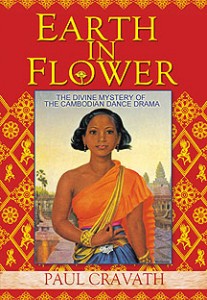Lost Dance Troupe of Cambodia-Book Review of Earth in Flower by Kaunana
Earth in Flower bears witness to rich history of royal Khmer dance tradition until the very end by Alex Salkever – Download a PDF of this article (273k)
© Copyright 2008 The University of Hawai’i – Kaunānā, the research publication of the University of Hawai‘i.

In 1974 the Cambodian Ministry invited James Brandon, the noted Asian Theater Scholar and a Professor at UH Manoa, to document the classical Khmer dance as practiced by the Royal Dance Troupe. Rehearsed in isolation by young women who performed only as permitted by the king, the troupe’s dances were rarely viewed by Westerners. The government wanted a record of what it considered the highest art form of the Khmer people. Brandon refused the invitation due to prior commitments but instead sent his graduate student Paul Cravath, who was interested in Southeast Asian theater.
Cravath landed in the capital of Phnom Penh just as the city came under attack by the brutal Khmer Rouge guerrillas. His mission took on a new urgency. “I understood then that they wanted to document the dance because they were worried the Khmer Rouge would obliterate it,” says Cravath.
He spent the next three months immersed in the culture of Khmer dance as one of the only Westerners ever to gain unfettered access to royal dancers. Cravath witnessed two hypnotic performances by the royal troupe, spent countless hours speaking to dancers and teachers, and attended rehearsals. He was also provided with full access to the library at Royal Palace where he perused dance performance programs stretching back decades. With diagrams, notes and photographs, Cravath rushed to document the art before the Khmer Rouge arrived.
His work unfinished, Cravath was evacuated From the country with other Americans on April 5, 1975. “We were allowed one piece of luggage and I stuffed mine full of research notes and photographs,” says Cravath, who boarded a C-130 for Bangkok under heavy rocket fire. Phnom Penh fell 12 days later on April 17th. Incredibly, the royal dancers continued their rehearsals until the very end. More than 90% of the Royal Dance Troupe and its teachers perished in the Cambodian genocide that followed.
A decade later Cravath completed a hefty 680-page PhD thesis covering the art form from its origins in mythology to modern times. The thesis detailed the choreography, musicology, costuming and stagecraft of a slow, mesmerizing style of a dance considered a divine art by the Khmer people. The book also chronicled the complicated role the dancers played in Cambodian culture and politics as both members of royalty and royal concubines. After initially inquiring about publishing the thesis, Cravath put the document into storage.
In 2006, Kent Davis called Cravath asking about the thesis. Davis, a publisher and independent researcher specializing in Southeast Asia, had seen a mention of the work in an ethnomusicology article. After reading Cravath’s work, Davis decided to republish it in book form. Over the next two years Cravath and Davis converted the raw thesis into a more polished 544-page book, entitled Earth in Flower, with hundreds of photos, paintings and engravings.
Intended mainly for libraries and collectors, only 886 copies of the work were printed. However, the impact is well beyond the numbers. “The text is of great importance and the project of having Earth in Flower published has been a labor of love,” says Helen Ibbitson Jessup, a noted Cambodia scholar and author of the book Art and Architecture of Cambodia. Says Cravath, “I had a sense I was writing this for the Cambodian people to ensure that all is not lost.”
